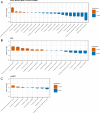Differences in bacterial taxa between treatment-naive patients with major depressive disorder and non-affected controls may be related to a proinflammatory profile
- PMID: 38297265
- PMCID: PMC10832199
- DOI: 10.1186/s12888-024-05547-z
Differences in bacterial taxa between treatment-naive patients with major depressive disorder and non-affected controls may be related to a proinflammatory profile
Abstract
Background: Major depressive disorder (MDD) is characterized by sadness and anhedonia, but also physical symptoms such as changes in appetite and weight. Gut microbiota has been hypothesized to be involved in MDD through gut-brain axis signaling. Moreover, antidepressants display antibacterial properties in the gastrointestinal tract. The aim of this study was to compare the gut microbiota and systemic inflammatory profile of young patients with MDD before and after initiation of antidepressant treatment and/or psychotherapy in comparison with a non-depressed control group (nonMDD).
Methods: Fecal and blood samples were collected at baseline and at follow-up after four and twelve weeks, respectively. Patients started treatment immediately after collection of the baseline samples. The gut microbiota was characterized by 16 S rRNA gene sequencing targeting the hypervariable V4 region. Plasma levels of 49 unique immune markers were assessed using Mesoscale.
Results: In total, 27 MDD patients and 32 nonMDD controls were included in the study. The gut microbiota in the baseline samples of MDD versus nonMDD participants did not differ regarding α- or β-diversity. However, there was a higher relative abundance of the genera Ruminococcus gnavus group, and a lower relative abundance of the genera Desulfovibrio, Tyzzerella, Megamonas, Olsenella, Gordonibacter, Allisonella and Rothia in the MDD group compared to the nonMDD group. In the MDD group, there was an increase in the genera Rothia, Desulfovibrio, Gordinobacteer and Lactobacillus, while genera belonging to the Firmicutes phylum were found depleted at twelve weeks follow-up compared to baseline. In the MDD group, IL-7, IL-8 and IL-17b levels were elevated compared to the nonMDD group at baseline. Furthermore, MDI score in the MDD group was found to correlate with Bray-Curtis dissimilarity at baseline, and several inflammatory markers at both baseline and after initiation of antidepressant treatment.
Conclusion: Several bacterial taxa differed between the MDD group and the nonMDD group at baseline and changed in relative abundance during antidepressant treatment and/or psychotherapy. The MDD group was furthermore found to have a pro-inflammatory profile compared to the nonMDD group at baseline. Further studies are required to investigate the gut microbiota and pro-inflammatory profile of patients with MDD.
Keywords: Depression; Gut-Brain Axis; Major depressive disorder; Microbiome; Microbiota.
© 2024. The Author(s).
Conflict of interest statement
The authors declare no competing interests.
Figures







Similar articles
-
Exploration of the Gut Microbiome in Thai Patients with Major Depressive Disorder Shows a Specific Bacterial Profile with Depletion of the Ruminococcus Genus as a Putative Biomarker.Cells. 2023 Apr 25;12(9):1240. doi: 10.3390/cells12091240. Cells. 2023. PMID: 37174640 Free PMC article.
-
Association analysis of gut microbiota and efficacy of SSRIs antidepressants in patients with major depressive disorder.J Affect Disord. 2023 Jun 1;330:40-47. doi: 10.1016/j.jad.2023.02.143. Epub 2023 Mar 3. J Affect Disord. 2023. PMID: 36871910
-
Characteristics of gut microbiota and its correlation with hs-CRP and somatic symptoms in first-episode treatment-naive major depressive disorder.J Affect Disord. 2024 Jul 1;356:664-671. doi: 10.1016/j.jad.2024.04.011. Epub 2024 Apr 12. J Affect Disord. 2024. PMID: 38615845
-
Major Depressive Disorder and gut microbiota - Association not causation. A scoping review.Prog Neuropsychopharmacol Biol Psychiatry. 2021 Mar 2;106:110111. doi: 10.1016/j.pnpbp.2020.110111. Epub 2020 Sep 23. Prog Neuropsychopharmacol Biol Psychiatry. 2021. PMID: 32976952
-
Microbiota-gut-brain axis: Natural antidepressants molecular mechanism.Phytomedicine. 2024 Nov;134:156012. doi: 10.1016/j.phymed.2024.156012. Epub 2024 Aug 31. Phytomedicine. 2024. PMID: 39260135 Review.
Cited by
-
The gut microbiota-brain connection: insights into major depressive disorder and bipolar disorder.Front Psychiatry. 2024 Nov 5;15:1421490. doi: 10.3389/fpsyt.2024.1421490. eCollection 2024. Front Psychiatry. 2024. PMID: 39564459 Free PMC article. Review.
References
Publication types
MeSH terms
Substances
LinkOut - more resources
Full Text Sources

